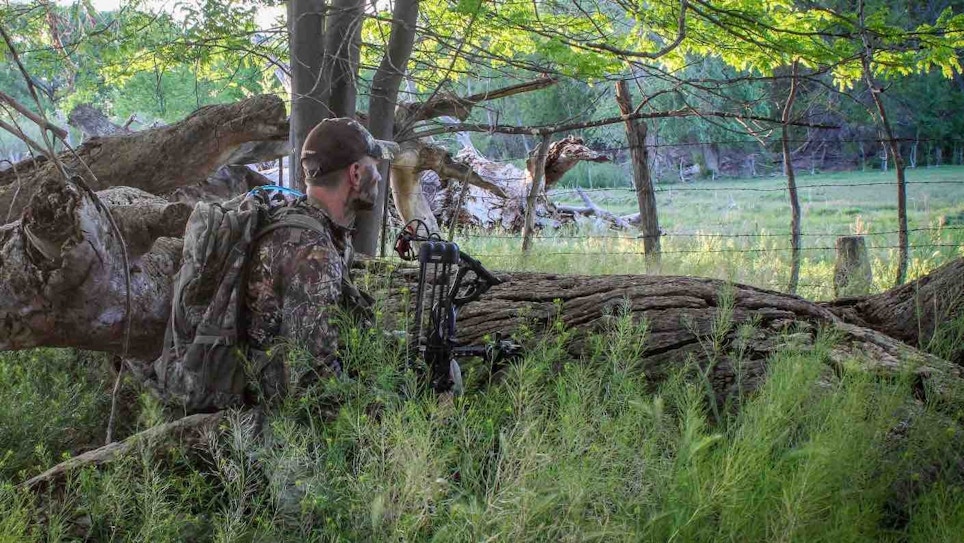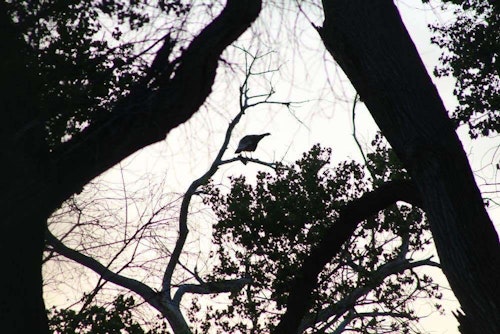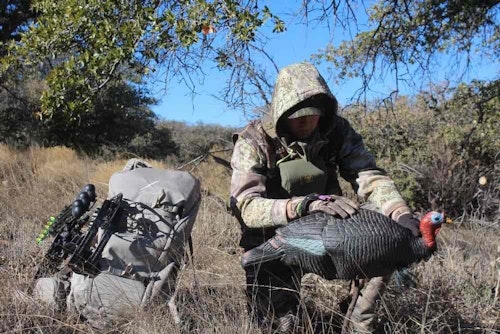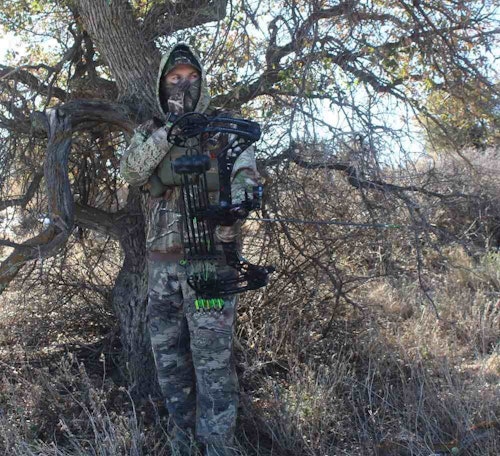
If the gobblers aren’t cooperating this spring, try mixing things up by being mobile and hunting them without a pop-up blind.
Picture this turkey bowhunting scenario: You creep into your ground blind in the twilight of dawn and place your decoys just a few yards away from your setup. As the rays of light start to reach the treetops, a roosted tom starts gobbling his head off. You answer with a few clucks and yelps. When he glides to the ground from his roost, he begins strutting like a cocky high school football player in front of the cheerleading squad. He consistently answers your sweet yelps, watching for the hen that is calling for his attention. Then, he locks eyes on your decoys and starts running in on a beeline.
As he gets a few feet from your mock tom and hen, he puffs himself up and starts drumming and dancing. He pivots away to beat the snot out of your intrusive tom decoy and as he does so, you draw back to your anchor point, settle your pin, and wait for him to turn and stop. The aggressive tom thumps the decoy with great agitation, then pauses briefly. Before he can reinstate his attack, your arrow is on its way and smacks the upper third of his breast, folding him to the ground instantly. You run out of your blind and collect your prized bird with admiration and humility.
While this is the ideal bowhunting situation, I’ve learned this doesn’t often play out. Instead, I have managed to successfully bowhunt turkeys by leaving the ground blind at home and hunting them straight from the ground. This method has allowed me to move freely on birds, adapt with different approaches, and have fewer limitations on shots I can take when a tom strolls within shooting distance. Plus, arrowing a red-faced tom just a few yards away without a blind is an incredibly thrilling experience.

Increased Mobility
A ground blind can be an advantage if turkeys do everything you want them to, but as previously mentioned, that doesn’t always happen. If you strictly bowhunt from a ground blind, you are limiting your ability to be mobile on toms. However, when bowhunting by foot on the ground you have the option to quickly make moves on gobblers that aren’t doing exactly what you want them to.
Bowhunting without a blind allows you to cover more ground, which can be beneficial for a couple of reasons. First, it allows you to roam more of a tom’s breeding area, which will often give you opportunities at birds if they don’t come in off the roost tree. I will cruise from one spot to another, calling occasionally until I get a gobbler to answer. Then, I’ll set up where I can attempt to call him in. Typically, the more area I cover, the more turkeys I get into.
A second benefit of being mobile is I gain knowledge about the local turkeys. Many of my best roost trees are ones I discovered while hunting without a blind. I’ve also been able to learn important details about where turkeys feed during the day, areas where they go to breed, and travel routes they use. Having this intel gives me more options.
There is also the time and effort required to haul in and set up a ground blind that isn’t required when bowhunting in the open air. I don’t have to worry about putting a blind in place before the hunt starts, or fumbling around with one in the dark. I can go right to where I want to hunt, set up my decoys, and call. If I want or need to move, I do it. Gone is the hassle of breaking down a blind and packing it on my back.

Adapt and React
Bowhunting turkeys without a blind gives you the freedom and flexibility to adapt to various situations as they come. If plans A, B or C fall through, then you can react to the actions of the turkeys and then, as the situation evolves, make a play on a tom. If you hunt only from your blind, your options are limited to that one option. Except for mixing things up on the calls, there is not much you can do if a strutter refuses to come in.
If a gobbler hangs up in a creek bottom, you can try charging in closer to him. If the birds you are chasing are answering your calls but heading in the opposite direction, you can circle them and restart a calling sequence or cut them off with an ambush. Maybe the tom you are pursuing shuts up; you can move on and go find another gobbler.
One late May, I was bowhunting Rio Grande turkeys in southern Kansas. Though the toms were still gobbling, most of their attention was focused on a couple of hens that hadn’t been bred, with little interest in coming to my calls. During the last evening, while sitting inside my blind, I could see multiple longbeards strutting around those few hens. They were 200 yards out and not coming any closer. So once the flock moved over a small rise, I bailed out of my blind and headed for the birds. I kept tabs on them with my binocular as I moved through cedars and waist-high grass. When they strutted over the next hill, I wasted no time in cutting the distance. With an arrow knocked, I peeked over the top of the rise to see turkeys everywhere. Then I noticed a big tom walking straight to me. When he got to what I guessed was 30 yards, I settled my second pin and zipped an arrow through his chest. By adapting to what the turkeys were doing and being willing to try an unconventional approach, I was able to end my hunt with a filled tag.
More Shot Opportunities
When bowhunting from a ground blind, your shooting options are quite literally limited to a couple of window openings. Your chance for a shot is banked on a tom coming directly in front of your hideout. I’ve had a couple of instances where toms came into my setup, but I wasn’t able to get a shot because the birds weren’t in front of the blind window.
If you’re bowhunting without a blind, it’s easier to see toms coming in sooner and prepare for a shot. Also, your shooting zone increases to nearly a 180-degree view, particularly if you’re standing. Of note, nearly every one of the shots I’ve taken outside a blind was standing. Having this extended shooting zone drastically increases the likelihood of releasing an arrow at a longbeard no matter where he comes in from. While standing, I can shoot an arrow from so many more angles than if I were hiding inside a blind.
Another advantage of shooting outside of a blind is there isn’t risk of your bow or arrow being altered by the blind or chair. Many bowhunters have had an arrow deflect after their broadhead or fletching contacted the blind’s window frame. Once, after shooting at a tom, I sent an arrow into oblivion because I forgot to watch for broadhead clearance and struck the corner of the blind window. Accuracy will also be stifled if your cam, riser or stabilizer contacts the blind or anything else while at full draw. These issues are much less of a concern when shooting in the open.

Arrowing a Bird Without a Blind
After placing my decoy in the predawn darkness, my brothers and I settled in for the morning sit, hoping to coax in a gobbler from the decade’s old cottonwoods. This conglomerate of trees was a frequent roost for strutting toms, and I had many close encounters at this exact location. For that reason, I was a bit surprised when our calls were met with dead silence. As it started to get light enough to see, a roosted tom gobbled a couple of times way off in the distance. It was still dark enough that we could move several hundred yards across the river-bottom without getting caught. So we quickly moved through the area, hustling to beat the birds to the ground.
After we hiked within 200 yards of the treeline, we once again tucked ourselves into some saplings and my brothers began calling. While the original gobbler we heard trailed a hen in the opposite direction, we stayed put because other birds began calling around us. Before long, a tom gobbled behind us. After several minutes of quiet, my brother let out another series of yelps and the bird responded at half the distance as before. There was no doubt he was coming.
It wasn’t long before the tom and two jakes walked just three paces from my brothers, who were hunkered beneath a limb. When I noticed the mature bird walking through the trees, I pivoted when he was behind a cottonwood. Then, when his head darted behind a low-hanging branch, I drew back. When the tom stepped into the clear at 17 yards, my top sight pin settled over his side, and I let the arrow loose. My fixed 3-blade head blew through the bird.
After giving the bird some time, we recovered the big, long-bearded Merriam’s. I was filled with enthusiasm and a smile filled my face. There is satisfaction in fooling a tom turkey with any tactic, but I think it is twice as exciting when done in the open air with a bow.
Had I done this hunt from a blind, I likely never would have gotten that shot. If I had hunted from a blind that morning, a tom may have wandered through, but I likely wouldn't have gotten on the toms I did after moving across the river flat. Being mobile and moving the half-mile to the next treeline gave me a new set of toms to pursue.
During this hunt I also had to make some adaptations. My original setup didn’t pan out the way I envisioned. The turkeys hadn’t roosted that night where I thought. My ability to change strategies on the fly was enabled by the fact I wasn’t tethered to a ground blind. I could change setups quickly and quietly without worrying about moving a blind.
Additionally, the toms that came in approached from the opposite direction than expected. This isn’t uncommon for turkeys, but being in a ground blind would have restricted my shot to its compact windows. Had I been in such a blind, I wouldn’t have gotten an arrow off at the tom as he came from behind us and then cut to the right.

Final Thoughts
If things aren’t going your way this turkey season, ditch the blind. By doing so, you’ll increase your mobility, adaptability and shot opportunities, which will hopefully lead you to wrapping a tag around the leg of a big mature tom.
Sidebar: Tips for Getting to Full Draw
It’s no secret that turkeys have excellent eyesight. However, you don’t have to be buried inside a blind to avoid getting caught when drawing your bow. Being well camouflaged is important, but remaining still when birds are within bow range is even more critical when hunting without a blind. I’ve had many birds walk right past me and never know I was there because I didn’t move. I also wear gloves and a face mask to keep any skin glare from giving away my position.
When moving in on a gobbler, I’ll set up in front of trees or shrubs that provide a good backdrop for me to blend into while still having room to draw. Additionally, choosing the right moment to draw back your bow is crucial to getting a shot at a tom rather than spooking him. I will patiently wait until I know the tom’s head is blocked. This could be a tree branch, my decoy, or the strutter’s fan. Once his eyes are blocked, I don’t hesitate to draw my bow because turkeys move quickly, and that window of opportunity is typically very short.
An important element to getting drawn on an incoming tom is your position, either standing, kneeling or sitting. Usually, I’ll set up in a standing position because it is easier to see birds approach and shoot. Occasionally, I’ll set up in a kneeling or sitting position to call. The trick is getting to a standing position without spooking birds.
When I hear a gobble within a couple of hundred yards, I’ll switch to standing. If I think the risk of spooking turkeys while transitioning from one position to another is too great, then I’ll remain standing and prepare to shoot from that position. For this reason, it is a good idea to practice shooting from a few different positions and angles before chasing gobblers with a bow.
Photos by Kyle S. Lipke





